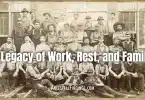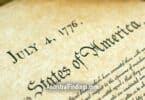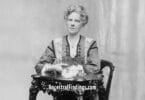Leif Eriksson was a famous Viking explorer from Iceland who is largely considered to have been the first European to set foot on the continent of North America. There is no longer any doubt that the Vikings did discover North America for the Europeans long before Christopher Columbus. The well-documented stories of Leif’s voyages seem to point to him as the leader of the first Norse expedition to North America. It is for this reason he is known and respected as an important historical person in both the history of North America and of Europe.
Leif Eriksson was the son of Erik the Red and Thjodhild. Erik was a well-known explorer in his own right, establishing the first European settlement in Greenland. Leif probably grew up on his family’s estate in eastern Greenland, called Brattahlio. He married a Norse noblewoman named Thorgunna and had two known sons by her, Thorgils and Thorkell.
Most historians estimate Leif’s year of birth as either 970 A.D or 980 A.D. and believe he was born in Iceland, as that is where his parents were married. He had two brothers and a sister who are known to history. At some point in Leif’s childhood, his father, Erik the Red, was banished from Iceland (much like Erik’s father before him had been banished from Norway and founded Iceland). Erik may have been banished for manslaughter as his father was from Norway, but the exact cause of his banishment from Iceland is uncertain. What historians do know is that Erik traveled west and took his wife and children, and eventually discovered Greenland and founded the first European settlement there in 986. Erik even gave the place its name of Greenland. It is in Greenland where Leif completed his growing up years and became an adult.
When Leif reached adulthood, he became an explorer just like his father and grandfather before him. On one of his first expeditions, he traveled with a crew to Norway in 999. While there, he became a vassal of Norway’s King Olaf Tryggvason and converted to Christianity. King Olaf gave Leif the task of bringing Christianity to Greenland. This was something Leif’s polytheistic father reacted angrily to, but which his mother eagerly accepted. Leif’s mother even founded her own Christian church in Greenland.
More than one Norse saga reports on Leif’s landfall in North America. He was not the first European to see the continent, as he had previously heard tales of a land to the west from a merchant named Bjarni Herjolfsson, who said he saw land to the west of Greenland when he was blown off course during a voyage. He did not go to this land, but he did see it, and Leif knew it was there. Leif reached North America by being blown off course during a voyage, just as Herjolfsson was. Only, Leif made landfall there. He reported finding plentiful fields of wheat and grapevines.(1) Some reports say he rescued two shipwrecked European sailors there, which, if true, would mean these men were the first Europeans to set foot on North America, but not every saga mentions them. Every saga says Leif set foot on North American soil, so he gets the honor of being officially named the first.
As winter was approaching when Leif and his crew landed in North America in what is today the Canadian province of Newfoundland, Leif decided to spend the winter there. He divided his men into two groups–one which would stay at the camp, and one which would explore. Because of all the grapevines, Leif named this new land Vinland. He later brought grapes and lumber from Vinland back to Greenland.
Because of Leif’s successful trip to Vinland and extended stay there, other Norsemen were encouraged to go on the journey. An early follower of Leif’s footsteps was his brother, Thorvald. Thorvald is said to be the first European to make contact with the native people of Vinland . . . an encounter that did not go well on either side, with violence being exchanged. Later voyages and encounters went much better, with regular trips to Vinland and trade with the natives becoming commonplace over the next few centuries. In fact, visits by Norsemen to Vinland were mentioned quite casually in the Norse sagas after the initial discovery, suggesting the existence of Vinland and the trips made to it were common knowledge. This knowledge may have even made its way to other parts of Europe. Christopher Columbus said he visited Iceland in 1477 in a letter he wrote, and he could well have heard stories of this land to the west when he was there.
Leif Eriksson died around 1020 A.D. and left his estates to his second son, who was more popular with the people of Greenland than his eldest son. He was a pioneer in European travel to North America and began a long history of Norse interaction with the natives of what is now Canada. It took the rest of Europe nearly 500 years to catch up with the accomplishments of Leif Eriksson in travel and exploration to the west. He is celebrated today as a leader and visionary in bringing Europeans to North America.






